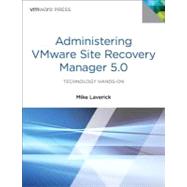
Preface xv
Acknowledgments xxi
About the Author xxiii
Chapter 1: Introduction to Site Recovery Manager 1
What’s New in Site Recovery Manager 5.0 1
A Brief History of Life before VMware SRM 5
What Is Not a DR Technology? 7
What Is VMware SRM? 10
What about File Level Consistency? 11
Principles of Storage Management and Replication 12
Summary 19
Chapter 2: Getting Started with Dell EqualLogic Replication 21
Creating an EqualLogic iSCSI Volume 23
Granting ESXi Host Access to the EqualLogic iSCSI Volume 26
Enabling Replication for EqualLogic 31
Using EqualLogic Host Integration for VMware Edition (HIT-VE) 39
Summary 42
Chapter 3: Getting Started with EMC Celerra Replication 43
Creating an EMC Celerra iSCSI Target 46
Granting ESX Host Access to the EMC Celerra iSCSI Target 51
Creating a New File System 56
Creating an iSCSI LUN 59
Configuring Celerra Replication 64
Summary 72
Chapter 4: Getting Started with EMC CLARiiON MirrorView 73
Creating a Reserved LUN Pool 75
Creating an EMC LUN 78
Configuring EMC MirrorView 80
Creating a Snapshot for SRM Tests 85
Creating Consistency Groups (Recommended) 88
Granting ESX Host Access to CLARiiON LUNs 90
Using the EMC Virtual Storage Integrator Plug-in (VSI) 93
Summary 95
Chapter 5: Getting Started with the HP StorageWorks P4000 Virtual SAN Appliance with Remote Copy 97
Some Frequently Asked Questions about the HP P4000 VSA 98
Downloading and Uploading the VSA 100
Configuring the VSA (Management Groups, Clusters, and Volumes) 108
Adding ESX Hosts and Allocating Volumes to Them 120
Summary 129
Chapter 6: Getting Started with NetApp SnapMirror 131
Provisioning NetApp NFS Storage for VMware ESXi 133
Creating NetApp Volumes for Fibre Channel and iSCSI 139
Configuring NetApp SnapMirror 147
Introducing the Virtual Storage Console (VSC) 155
Summary 158
Chapter 7: Installing VMware SRM 161
Architecture of the VMware SRM 161
Setting Up the VMware SRM Database with Microsoft SQL Server 2008 180
Installing the VMware SRM Server 186
Summary 199
Chapter 8: Configuring vSphere Replication (Optional) 201
How vSphere Replication Works 201
vSphere Replication Limitations 203
Installing vSphere Replication 205
Enabling and Monitoring vSphere Replication 217
Summary 223
Chapter 9: Configuring the Protected Site 225
Connecting the Protected and Recovery Site SRMs 226
Configuring Inventory Mappings 231
Assigning Placeholder Datastores 237
Configuring Array Managers: An Introduction 241
Creating Protection Groups 257
Failure to Protect a Virtual Machine 262
Summary 267
Chapter 10: Recovery Site Confi guration 269
Creating a Basic Full-Site Recovery Plan 269
Testing Storage Configuration at the Recovery Site 273
Practice Exercise: First Recovery Plan Test 281
Cleaning Up after a Recovery Plan Test 283
Controlling and Troubleshooting Recovery Plans 285
Recovery Plans and the Storage Array Vendors 291
Summary 295
Chapter 11: Custom Recovery Plans 297
Controlling How VMs Power On 299
Adding Additional Steps to a Recovery Plan 309
Configuring IP Address Changes for Recovery Virtual Machines 329
Managing Changes at the Protected Site 337
Multiple Protection Groups and Multiple Recovery Plans 350
The Lost Repair Array Managers Button 354
Summary 354
Chapter 12: Alarms, Exporting History, and Access Control 357
vCenter Linked Mode and Site Recovery Manager 357
Alarms Overview 360
Exporting and History 366
Access Control 368
Summary 372
Chapter 13: Bidirectional Relationships and Shared Site Configurations 375
Configuring Inventory Mappings 376
Refreshing the Array Manager 378
Creating the Protection Group 380
Creating the Recovery Plan 381
Using vApps to Control Start-Up Orders 381
Shared Site Confi gurations 384
Installing VMware SRM with Custom Options to the New Site (Washington DC) 387
Installing VMware SRM Server with Custom Options to the Recovery Site 390
Pairing the Sites Together 392
Decommissioning a Site 394
Summary 394
Chapter 14: Failover and Failback 397
Planned Failover: Protected Site Is Available 400
Unplanned Failover 415
Summary 421
Chapter 15: Scripting Site Recovery 423
Scripted Recovery for a Test 425
Summary 432
Chapter 16: Upgrading from SRM 4.1 to SRM 5.0 433
Upgrading vSphere 435
Upgrading Site Recovery Manager 451
Summary 463
Index 465
The New copy of this book will include any supplemental materials advertised. Please check the title of the book to determine if it should include any access cards, study guides, lab manuals, CDs, etc.
The Used, Rental and eBook copies of this book are not guaranteed to include any supplemental materials. Typically, only the book itself is included. This is true even if the title states it includes any access cards, study guides, lab manuals, CDs, etc.